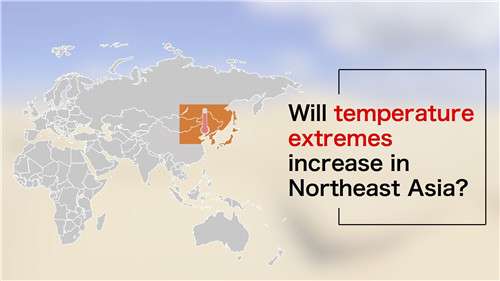Will temperature extremes increase in Northeast Asia?

Northeast Asia includes the areas of Northeast China, the Russian Far East, Japan and the Korean Peninsula. Climate variability and change impose enormous challenges for this region, with its rapidly developing economy and large population. Natural climate variability and anthropogenic forcings modulate regional climate, particularly in regions sensitive to global climate change, such as Northeast Asia.
To investigate to what extent natural variability or anthropogenic forcings affect the regional climate of Northeast Asia, scientists from University of Reading (U.K.) and Institute of Atmospheric Physics (CAS, China) carried out an attribution study by performing a set of numerical experiments with different forcings.
"Northeast Asia has experienced abrupt summer warming and changes in temperature extremes since the mid-1990s," says Dr. DONG Buwen from University of Reading. "And accompanying the warming in surface mean temperature, significant changes in certain temperature extremes, characterized by increases in the summer mean daily maximum temperature, daily minimum temperature, annual hottest day temperature, and annual warmest night temperature, have been observed."
Climate model experiments forced by changes in SST/sea ice extent (SIE) and anthropogenic forcings reproduced the general patterns of observed changes. Meanwhile, experiments forced by individual forcings suggested that changes in SST/SIE play a dominant role in summer mean surface warming, but reduced aerosol precursor emissions over Europe play an important role in changes of some temperature extremes, mainly through aerosol-induced coupled atmosphere-land surface feedback processes.
"As long as GHG concentrations continue to increase and anthropogenic aerosol precursor emissions over both North America and Europe continue to decrease, the abrupt summer surface warming and increases in hot temperature extremes over Northeast Asia since the mid-1990s will probably sustain in the next few decades," predicts Dr. DONG.
Additionally, Dr. DONG's team also applied this attribution study to Western Europe and the Sahel region, to better understand the variability and change in regional climate.
More information: Buwen Dong et al, Abrupt summer warming and changes in temperature extremes over Northeast Asia since the mid-1990s: Drivers and physical processes, Advances in Atmospheric Sciences (2016). DOI: 10.1007/s00376-016-5247-3
Provided by Chinese Academy of Sciences


















